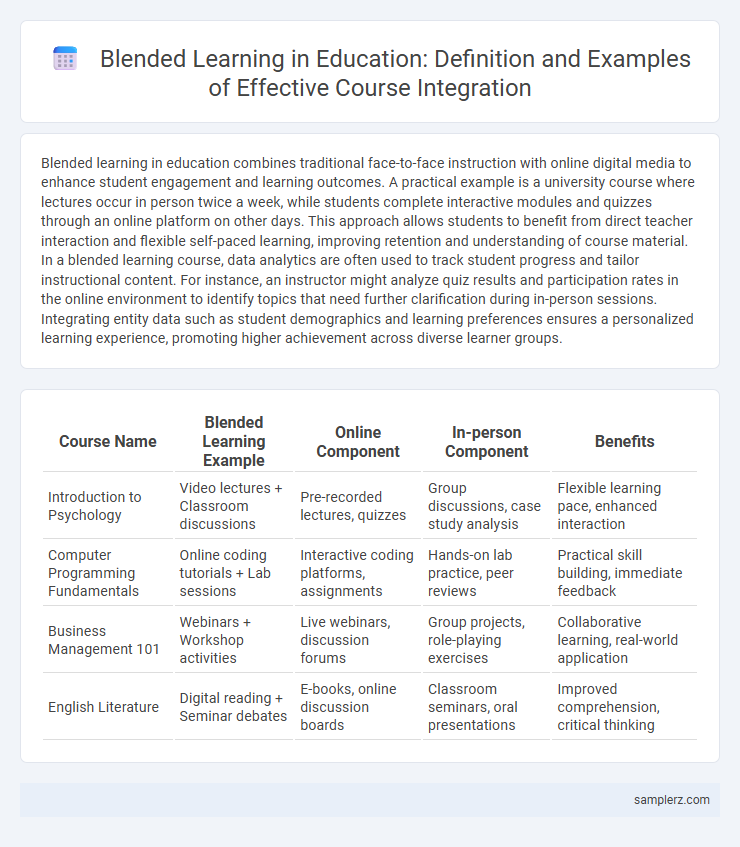Blended learning in education combines traditional face-to-face instruction with online digital media to enhance student engagement and learning outcomes. A practical example is a university course where lectures occur in person twice a week, while students complete interactive modules and quizzes through an online platform on other days. This approach allows students to benefit from direct teacher interaction and flexible self-paced learning, improving retention and understanding of course material. In a blended learning course, data analytics are often used to track student progress and tailor instructional content. For instance, an instructor might analyze quiz results and participation rates in the online environment to identify topics that need further clarification during in-person sessions. Integrating entity data such as student demographics and learning preferences ensures a personalized learning experience, promoting higher achievement across diverse learner groups.
Table of Comparison
| Course Name | Blended Learning Example | Online Component | In-person Component | Benefits |
|---|---|---|---|---|
| Introduction to Psychology | Video lectures + Classroom discussions | Pre-recorded lectures, quizzes | Group discussions, case study analysis | Flexible learning pace, enhanced interaction |
| Computer Programming Fundamentals | Online coding tutorials + Lab sessions | Interactive coding platforms, assignments | Hands-on lab practice, peer reviews | Practical skill building, immediate feedback |
| Business Management 101 | Webinars + Workshop activities | Live webinars, discussion forums | Group projects, role-playing exercises | Collaborative learning, real-world application |
| English Literature | Digital reading + Seminar debates | E-books, online discussion boards | Classroom seminars, oral presentations | Improved comprehension, critical thinking |
Introduction to Blended Learning in Modern Education
Blended learning in modern education combines online digital media with traditional classroom methods, exemplified by courses like "Introduction to Blended Learning," which integrate video lectures, interactive assessments, and face-to-face discussions. Platforms such as Canvas or Moodle support this model by offering flexible access to course materials and real-time feedback. Research shows that this hybrid approach improves student engagement and knowledge retention by catering to diverse learning styles.
Key Components of a Blended Learning Course
Blended learning courses integrate online digital media with traditional face-to-face classroom methods, incorporating key components such as interactive multimedia content, real-time instructor feedback, and flexible scheduling. Students engage with video lectures, quizzes, and discussion forums, enhancing personalized learning experiences while maintaining direct teacher guidance. This approach leverages technology to facilitate active participation, continuous assessment, and collaborative learning environments.
Flipped Classroom: A Blended Learning Example
The Flipped Classroom model exemplifies blended learning by reversing traditional teaching methods, where students engage with lecture materials, such as videos and readings, at home and participate in interactive activities during class time. This approach enhances comprehension and retention by allowing educators to facilitate personalized support and collaborative problem-solving in the classroom. Research indicates that Flipped Classroom techniques improve student engagement and academic performance across various education levels.
Integrating Online and In-Person Activities
Blended learning courses combine online modules with face-to-face instruction to enhance student engagement and flexibility. For example, a biology course might use online simulations to demonstrate complex cellular processes, while in-person labs allow hands-on experimentation and group discussions. This integration supports diverse learning styles and reinforces understanding by alternating between digital content and real-world application.
Case Study: Blended Learning in Language Courses
Blended learning in language courses often combines online interactive modules with traditional classroom instruction, enhancing vocabulary acquisition and speaking practice. Case studies demonstrate that integrating digital tools like language apps and virtual classrooms increases student engagement and proficiency. Research indicates that learners in blended language courses achieve higher retention rates and improved communicative skills compared to conventional methods.
Technology Tools Used in Blended Learning
Blended learning courses commonly incorporate technology tools such as Learning Management Systems (LMS) like Moodle or Canvas, which facilitate seamless integration of online and face-to-face instruction. Interactive platforms such as Google Classroom and Microsoft Teams enable real-time collaboration, assignment submission, and feedback. Video conferencing tools like Zoom and digital content creation software enhance synchronous learning experiences and personalized content delivery.
Benefits of Blended Learning for Students
Blended learning combines traditional classroom instruction with online educational resources, allowing students to access diverse learning materials anytime, enhancing their understanding and retention. This approach promotes personalized learning experiences by enabling students to progress at their own pace and revisit complex concepts through interactive digital content. Improved student engagement, flexibility, and immediate feedback contribute to higher academic achievement and greater motivation in blended learning environments.
Challenges in Implementing Blended Learning
Implementing blended learning in education faces challenges such as ensuring reliable access to technology and internet connectivity for all students, which can create disparities in participation. Instructors often struggle with balancing online and face-to-face instruction while maintaining consistent engagement and motivation across both modalities. Also, the need for comprehensive training and support for educators in using digital tools effectively remains a significant barrier to successful blended learning adoption.
Teacher’s Role in a Blended Learning Environment
In a blended learning environment, the teacher acts as a facilitator who designs flexible lesson plans combining online resources and face-to-face instruction to meet diverse student needs. They monitor student progress through digital analytics tools, providing personalized feedback and targeted interventions. By fostering collaboration in both virtual and physical spaces, teachers enhance engagement and support deeper understanding.
Assessment Strategies in Blended Learning Courses
Assessment strategies in blended learning courses often combine online quizzes with in-person presentations to enhance student engagement and comprehension. Incorporating formative assessments such as discussion boards and peer reviews allows instructors to monitor progress continuously and provide timely feedback. Data from learning management systems helps tailor assessments to individual learner needs, improving overall academic performance.

example of blended learning in course Infographic
 samplerz.com
samplerz.com